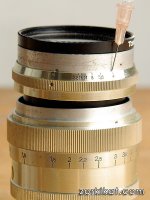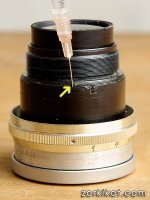ZorkiKat, Brian et al. I have exactly this problem. my J-9 has stiff old grease in it, but dont even want to try DIY CLA due to numerous warnings in this site. I screw optics module out, put in little oil but its not enough, full disassembly and cleaning would be needed. had the lens looked at my local camera service shop, but they dont understand much these old LTM lenses, it came back with comments "just use it and be happy" 🙂
[...]
edit: sorry for hijack the thread.
Jarski, one of the reasons, which I believe that J-9 fail to work properly is in the grease used. The threads on the helicoids are not as fine as would be needed for the different actions involved (converting the lens' relative focus position to the cam movement) during the focusing and RF coupling actions. The Soviets may have solved this by putting thick viscous grease to tighten up the gaps.
The first 2 J9s I had focus problems. One was moving the RF coupling cam at the wrong lengths needed, and the other was right at infinity (the cam should extend 7.5mm from the lens' mount surface) and at 1.15m (4.9mm). The former obviously needed to be reassembled for proper camming, but the latter wasn't camming right at the intermediate distances.
The latter lens's barrel also turned very smoothly. It had the smell of new grease too. The repairer had replaced the old grease with a new light one.
Noting that my heavy-turning J-9 focused right, I thought that the grease may have something to do with it. So I took the lens apart, and removed the "new grease"- not much as it was light- and replaced it with heavier automotive axel grease.
This grease made the barrel turn with more effort. But it made the focusing more accurate.
As for the hard-to-turn aperture ring, here's one non-invasive solution:
You'd need some lighter fluid, a bit of sewing machine oil, and an insulin syringe.
Inject, sparingly some lighter fluid into the groove between the aperture ring and the barrel. Apply minute amounts first, then turn the ring. Some dirty liquid may ooze out. When the ring can turn freely, that should be enough.
Do the same on the inside part of the ring too. The edge of the aperture ring is near the part of the optic block which sits in the barrel. Apply some lighter fluid too, but do this even more sparingly. Be careful not to put too much or some may get inside the optics.
And in case the ring tightens again when the lighter fluid dries, make up a 1/4 sewing machine oil + 3/4 lighter fluid mixture. Inject this in the exterior ring groove and turn the ring immediately to spread the mixture.
This is what I've done with tight J-9 aperture rings since 2001. None of them had to be reoiled since.



